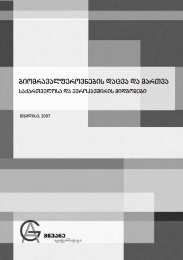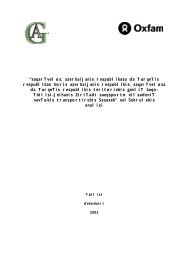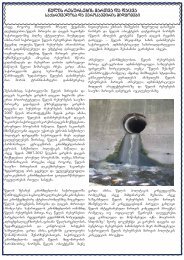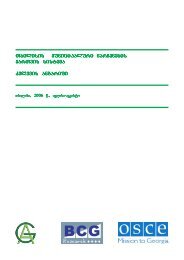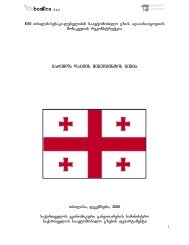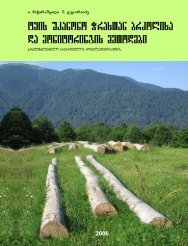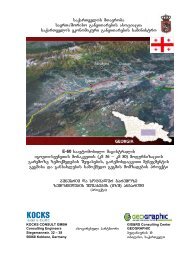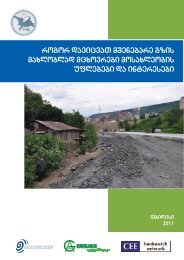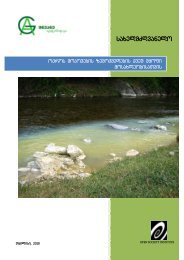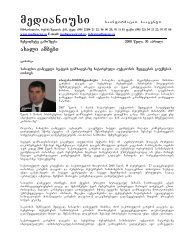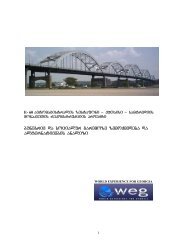Part I
Part I
Part I
Create successful ePaper yourself
Turn your PDF publications into a flip-book with our unique Google optimized e-Paper software.
Draft Black Sea Regional Transmission Project ESIA<br />
lowland zone, scouring, flooding-accumulation dominate, while landslide and gullying<br />
processes are negligible. In the hilly foothills the major processes are landslide and erosion.<br />
In the low and medium mountains a zone-wide spectrum of geodynamic processes can be<br />
observed.<br />
The risk of earthquakes is high in this region, with seismic activity in the 7-8 magnitude zone<br />
(Dzirula crystalline massif, Adjara-Imereti ridge, Okriba mountain massif). Landslides poses<br />
serious risks to industrial and economical activities in the region, with the landslide damage<br />
coefficient for Imereti estimated as 0.7-0.9.<br />
Bank erosion (scouring) is observed in 229 areas in the region, with a total length of<br />
527kilometers. Erosion affects arable lands, roads, bridges, irrigation hydrotechnical and<br />
bank protection facilities, oil and gas pipelines, and cause damages to some. Gullying is<br />
registered in 484 areas, with a total length of 257.3 kilometers.<br />
Rock and scree avalanches (16 and 254 units respectively), are mainly concentrated in the<br />
mountain regions in river headwaters and rocky areas of the ravines, as well as along the<br />
slopes cut during road construction. Mudflows are less frequent, with 136 mudflow gullies<br />
having been observed. Activation of the mudflow processes endangers some residential<br />
areas including Chiatura and Sachkhere, as well as Baghdati, Sairme, Baghdadi- Sakreula,<br />
Bagdati-Khani , Shorapan-Salieti, Sestaphoni-Rikoti, Khvani, Sachkhere road sections,<br />
Tsipa-Lashi, Shorapan-Chiatura individual sections of the railroad, where stone-mud flows<br />
hinder traffic.<br />
Flooding and accumulation processes (spring-autumn) are observed in separate sections of<br />
Sachkherte, Kolkheti and Akhalsopeli lowlands. There are 32 sections subject to flooding in<br />
the region,. Floods damage arable lands, irrigation and hydrotechnical facilities, pipelines,<br />
roads, protective engineering constrictions, industrial objects, settlements (including<br />
Sachkhere, Zestaphoni, Kutaisi, Vani, and Samytredia residential areas and infrastructure).<br />
In total flooded areas may reach hundreds of hectares.<br />
In areas with carbonate rocks, karst processes are observed, with 121 units with different<br />
forms of karst processes being registered in Khoni, Tskhaltubo, Terjola, Tkibuli, Chiatura,<br />
Sachkhere and Kharagauli. They are rare in Vani and Samtredia areas.<br />
Avalanches are occasionally observed in unpopulated high mountain areas of Kharagauli,<br />
Badati, Vani, Tkibuli, Chiatura and Sachkhere regions. The area belongs to medium<br />
mudflow risk (risk category 0.3-0.1) and high risk of landslides (risk category 0.9-0.7).<br />
4.1.5.3 Seismic hazards<br />
The Greater and Lesser Caucasus form the central Asian segment of the ‘Alpine-Himalayan<br />
Fault and Fold Belt’Akhaltsikhe Basin. This belt extends from the Swiss Alps in southern<br />
Europe to the Himalayan ranges of India and Nepal. The region is actively being deformed<br />
by the collision of the African, Arabian, and Indian tectonic plates with the southern margin of<br />
the Eurasian continent. The east-west trending faults are characterized by compressive<br />
thrust movements. The north-east or north-west trending faults generally exhibit lateral<br />
strike-slip movements.<br />
Two types of fault movement are commonly observed along the study area, namely Reverse<br />
and Thrust Faulting. Both are compressive styles of faulting and involve one fault block<br />
pushing up and over the second fault block. The ‘thrust’ and ‘reverse’ designations are<br />
distinguished by the dip angle of the fault plane. Thrust faults are characterized by dip<br />
angles of less than 45 degrees, and Reverse faults exhibit dip angles of greater than 45<br />
degrees.<br />
56



